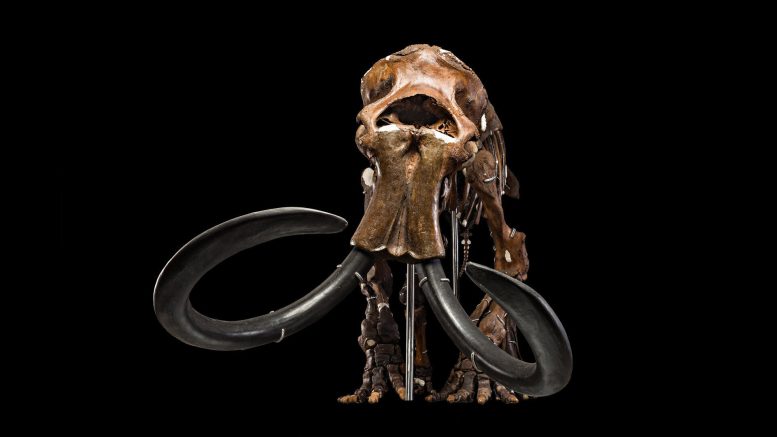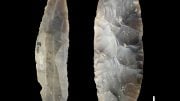
Fifty thousand years ago, North America was home to megafauna like mammoths and saber-toothed tigers. Their extinction, possibly due to human arrival or climate change, remains unsolved. Using ZooMS technology, researchers analyzed old bones from the Smithsonian Museum, emphasizing the importance of preserving archaeological collections for future discoveries. USNM 23792, Mammuthus primigenius, or Woolly Mammoth (composite), Department of Paleobiology, Smithsonian Institution. Credit: Gary Mulcahey
New research explores the unresolved mystery of the extinction of ancient North America’s megafauna, highlighting new research using ZooMS to analyze fragmented bones from the Smithsonian’s collections. It stresses the significance of preserving archaeological collections for uncovering details about past life and extinctions.
Dr. Mariya Antonosyan, a molecular archaeologist at the Max Planck Institute of Geoanthropology, Dr. Torben Rick, a curator at the Smithsonian National Museum of Natural History, and Prof. Nicole Boivin, also of the Max Planck Institute, collaborated on a recent article published in Frontiers in Mammal Science. Utilizing innovative methods, they analyzed fossil bone fragments at the Smithsonian’s National Museum of Natural History. Their research offers new insights that could enhance our understanding of the factors and impacts related to the extinction of large mammals.
50,000 years ago, North America was ruled by megafauna. Lumbering mammoths roamed the tundra, while forests were home to towering mastodons, fierce saber-toothed tigers, and enormous wolves. Bison and extraordinarily tall camels moved in herds across the continent, while giant beavers plied its lakes and ponds. Immense ground sloths weighing over 1,000 kg were found across many regions east of the Rocky Mountains.
And then, sometime at the end of the Last Ice Age, most of North America’s megafauna disappeared. How and why remains hotly contested. Some researchers believe the arrival of humans was pivotal. Maybe the animals were hunted and eaten, or maybe humans just altered their habitats or competed for vital food sources. But other researchers contend that climate change was to blame, as the Earth thawed after several thousand years of glacial temperatures, changing environments faster than megafauna could adapt. Disagreement between these two schools has been fierce and debates contentious.
Despite decades of study, this Ice Age mystery remains unsolved. We simply don’t have sufficient evidence at this point to rule out one scenario or the other – or indeed other explanations that have been proposed (eg disease, an impact event from a comet, a combination of factors). One of the reasons is that many of the bones through which we track the presence of megafauna are fragmented and difficult to identify. While some sites preserve megafaunal remains really well, conditions at others have been tough on the animal bones, wearing them down into smaller fragments that are too altered to identify. These decay processes include exposure, abrasion, breakage, and biomolecular decay.
Such problems leave us lacking critical information about where particular megafaunal species were distributed, exactly when they disappeared, and how they responded to the arrival of humans or the climatic alteration of environments in the Late Pleistocene.
Applying Modern Technology to Old Bones
Our work has set out to address this information deficit. To do so, we have turned our attention to the exceptional collections of the Smithsonian National Museum of Natural History in Washington, DC. Housing the findings of numerous archaeological excavations conducted over the past hundred years, the Museum is an extraordinary reservoir of animal bones that are deeply relevant to the question of how North America’s megafauna went extinct. Yet many of these remains are heavily fragmented and unidentifiable, meaning their ability to shed light on this question has, at least up until now, been limited.

The preparation of a sample plate for ZooMS analysis. The tiny droplets being deposited using the pipette contain small amounts of ground up collagen that will be analyzed on a mass spectrometer. Credit: Samantha Brown
Fortunately, recent years have seen the development of new biomolecular methods of archaeological exploration. Rather than heading out to excavate new sites, archaeologists are increasingly turning their attention to the scientific laboratory, using new techniques to probe existing material.
One such novel technique is called ZooMS – short for Zooarchaeology by Mass Spectrometry. The method relies on the fact that while most of its proteins degrade quickly after an animal dies, some, like bone collagen, can preserve over long time periods. Since collagen proteins frequently differ in small, subtle ways between different taxonomic groups of animals, and even individual species, collagen sequences can provide a kind of molecular barcode to help identify bone fragments that are otherwise unidentifiable. So, collagen protein segments extracted from minute quantities of bone can be separated and analyzed on a mass spectrometer to perform the identifications of remnant bones that traditional zooarchaeologists cannot.
Selecting Archaeological Material for Study
We decided to use this method to revisit the Smithsonian Museum’s archived material. Our study was a pilot one that asked the key question: would bones housed in the Smithsonian Museum preserve sufficient collagen for us to learn more about fragmented bone material in its storerooms? The answer was not obvious, because many of the excavations had taken place decades ago. While the material had been stored for the last decade or so in a state-of-the-art, climate-controlled facility, the early date of the excavations meant that modern standards were not necessarily applied to their handling, processing, and storage at all stages.
We examined bone material from five archaeological sites. The sites all dated to the Late Pleistocene/earliest Holocene (c. 13,000 to 10,000 calendar years before present) or earlier and were located in Colorado, in the western United States. The earliest had been excavated in 1934, the latest in 1981.
Although some of the material from the sites was identifiable, much of it was highly fragmented and did not retain diagnostic features that could enable zooarchaeological identification to species, genus or even family. Some of the bone fragments looked highly unpromising – they were bleached and weathered, or edge-rounded, suggesting they had been transported by water or sediment prior to burial at the site.

1961 excavation at Lamb Spring, showing Ed Lewis (standing on left) and Waldo Wedel, along with two fieldmen. Glenn Scott can be seen in the excavation pit alongside some mammoth bones wrapped in plaster jackets for preservation. Credit: USGS
Discovering Excellent Biomolecular Preservation
What we found surprised us. Despite the old age of many of the collections, the unpromising appearance of much of the material, and the ancient origins of the bones themselves, they yielded excellent ZooMS results. In fact, a remarkable 80% of the bones sampled yielded sufficient collagen for ZooMS identifications. 73% could be identified to genus level.
The taxa we identified using ZooMS included Bison, Mammuthus (the genus to which mammoths belong), Camelidae (the camel family), and possibly Mammut (the genus to which mastodons belong). In some cases, we could only assign the specimens to broad taxonomic groups because many North American animals still lack ZooMS reference libraries. These databases, which are comparatively well developed for Eurasia but not for other regions, are essential for identifying the spectra a sample produces when we run it on a mass spectrometer.
Our findings have major implications for museum collections. The material we looked at is in every way the poor cousin of the glamorous material that goes on display in natural history museums. To look at, these highly fragmentary, small, and undiagnostic animal bones are uninspiring and superficially uninformative. But like other biomolecular tools, ZooMS is revealing the rich information retained in neglected specimens that have drawn neither researcher nor visitor attention for decades.
Our results also highlight the potential of such collections for addressing ongoing debates about exactly when, where, and how megafauna went extinct. By opening up for analysis of the fragmented bone material that makes up much of the megafaunal record, ZooMS has the potential to help provide much new research data to address long-standing questions about megafaunal extinctions. ZooMS offers a relatively easy, rapid, and cheap way to extract new information from long-ago excavated sites.
Our research also highlights the importance of preserving archaeological collections. When researchers and institutions are strapped for funding, archaeological artifacts and bones that are not glamorous or of obvious immediate benefit may be neglected or even discarded. It is critical that museums are provided with adequate funding to care for and house archaeological remains over the long term. As our analysis shows, such old material can find new life in unexpected ways – in this case, allowing us to use tiny bone fragments to help get a little closer to solving the mystery of why some of Earth’s largest ever animals disappeared from the landscapes of ancient North America.
Reference: “A new legacy: potential of zooarchaeology by mass spectrometry in the analysis of North American megafaunal remains” by Mariya Antonosyan, Eden Hill, Margaret Jodry, Noel Amano, Samantha Brown, Torben Rick and Nicole Boivin, 24 April 2024, Frontiers in Mammal Science.
DOI: 10.3389/fmamm.2024.1399358









“… fierce saber-toothed tigers, …”
The preferred term has been “cats,” not “tigers,” for decades. We have no idea whether they had stripes or not.
While I appreciate the topic and the extensive work the team has done, I find the title wildly misleading. For all that is written in the article, “We have identified these animals” does not give major clues toward their extinction per se.
Personally, I still find the overkill hypothesis convincing, as comparable climate changes had occurred some millennia before and only Homo sapiens was entirely new to the situation.
Sure,we killed them all. Idiots
Presumably, the large herbivores (“lunch” in Human”) had adapted their population sizes and reproduction to to the large carnivores and available resources. See Malthus One more effective carnivore and their math was wrong.
And carnivores; we’re humans, we hold a grudge, mess with us and we kill you.
Picture a gob of left-over venison liberally salted with debitage (scraps from sharpening your spear). Not much effort there.
As is all too typical, the article does not provide a single clue to what happened.